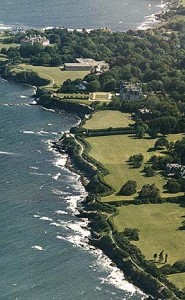I decided to write a piece on the top ten historical attractions in Newport RI to assist our guests if time is short. Most if not all of these landmarks are within walking distance of the Marshall Slocum Inn and/or have free ample parking. Although there are significantly more than 10 historical landmarks we decided to offer a top ten list to guide our guests when visiting Newport. For those guests who are staying longer at the bed and breakfast there are many more places and sites to see than these ten.
- The Breakers – The Breakers is undoubtably the most famous tourist attraction in Newport RI for domestic and international visitors. Completed in 1895, The Breakers is a concrete example of the Vanderbilt families exorbant wealth derived from, amongst other things, the New York Central Railroad. This National Historic Landmark consists of 70 rooms adorned with rare marble, alabaster, and gilded woods. Perhaps the most enjoyable feature of the Breakers are the spectacular views of the Atlantic Ocean and the historic Cliff Walk.
- Touro Synagogue – The Touro Synagogue is the quintessential example of Roger Williams’s promotion of religious tolerance and could be a main topic of why Rhode Island is it’s own state. Completed in 1763, the Synagogue became the first accepted active place of worship in the United States for Jewish persons. During the British occupation of Newport RI the synagogue survived burning due to it’s usefulness to the British troops as a hospital and meeting place. Recently, a beautiful new visitors center was completed giving tourists a great resource to learn about Judah Touro and his followers.
- The Marble House – Inspired by the Petit Trianon at Versailles, the Marble House is the other grand property of the Vanderbilt family. The house is ordained with gold and marble throughout which architect, Richard Morris Hunt, intended to be a statement of wealth during the infamous Gilded Age. Alva Vanderbilt, the properties owner, held her “Votes for Women” rallies at the mansion as part of her lifelong commitment to women’s rights.
- Rough Point – Rough Point is the home of Doris Duke, heiress and art collector who turned her good fortune into a life’s work in philanthropy. Most of Duke’s fortune came from the tobacco plantations owned by her family and she is said to have donated up to $400 million throughout her lifetime. Her philanthropic legacy continues today throughout the City of Newport by means of the Newport Restoration Foundation and the Doris Duke Foundation.
- National Museum of American Illustration – The National Museum of American Illustration is perhaps the most under visited and cautiously marketed attraction in Newport. Located at Vernon Court, a Gilded Age mansion on Bellevue Avenue, the building hosts the first national museum devoted exclusively to American illustration art, featuring Norman Rockwell, Maxfield Parish, JC Leyendecker, NC Wyeth, Jessie Willcox Smith, and 150 other artists.
- The Elms – A personal favorite of the staff at the Inn, The Elms was completed in 1901 as a summer retreat for coal magnate Edward Berwin and his wife Herminie. Features of the house include modern amenities that were unheard of at the time as well as floor to ceiling artwork and tapestries. Perhaps the best part of the Elms preservation is the behind the scenes tour where visitors can see the staff living quarters, boiler room, laundry room, kitchen, and the secret roof deck with expansive views of Newport and the Atlantic Ocean.
- Fort Adams – Situated in a strategic location overlooking Narragansett Bay, Fort Adams is a unique example of coastal defense systems utilized pre Revolutionary War up to World War II. Visitors can take a guided tour of the interior of the fort, the many underground tunnels, and the amazing overlook posts with 360 degree views of Aquidneck Island and Narragansett Bay. Fort Adams is also home to the Jazz and Folk Festivals which occur each summer in Newport.
- The Newport Mill – The Newport Mill is located in beautiful Touro Park and is thought to be the oldest remaining structure in Newport. There is no confusion about it’s usage from the 18th century onward but the debate rages on as to the buildings origin and purpose. Some theories point to an astronomical tool and others to an observatory for the Chinese. In a document of 1741 the tower is described as “the old stone mill” an d in 1760 the Tower was used as a haymow. During the American Revolution, the tower was used by the Americans as a lookout, and by the British to store ammo.
- The Cliff Walk – Other than the Breakers the Cliff Walk is perhaps the number one tourist attraction in Newport. Although there is not a lot of historical facts associated with the walk it offers too many beautiful scenic views and has been around since the Gilded Age to be left off this list. The 3.5 mile walk was used by the Vanderbilts and all their wealthy neighbors on walks to Easton’s Beach. In 1975 the walk was designated as a National Historic Trail, the first in New England.
- Washington Square – Two of Colonial America’s most significant structures are located at either end of Washington Square, the Colony House and the Brick Market. Built in 1741, the Colony House is one of the best maintained surviving Georgian buildings in the United States. The stately building was used for the colonial legislature during the fight for independence. Another example of classic Georgian architecture is the Brick Market built in 1762. The traditional open first level served as a marketplace for trading, much like Fanueil Hall in Boston.


